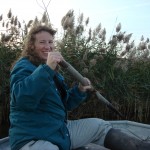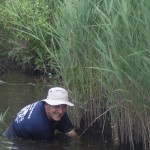by Heather Soulen
The Need for Healthy Marshes
Ten years ago, on August 28, 2005, Hurricane Katrina nicked south Florida and entered the heat-charged waters of the Gulf of Mexico, transforming from a Category 1 hurricane into a super-charged Category 5. In the early morning hours of August 29, it ripped through Louisiana and Mississippi. Thousands died, and hundreds of thousands of homes and businesses were destroyed. Today, much of the Louisiana and Mississippi coasts, and its people, are still recovering from the devastation.
When Katrina hit, some coastal marshes east of the Mississippi River lost approximately 25 percent of their area. In the decade that followed, salt marshes and wetlands in Louisiana have continued to disappear in some places, but not others. The scientific community soon zeroed in on keeping marshes healthy, since, as one scientist remarked “A healthy marsh is pretty resilient, A stressed marsh – storms will physically break the marsh down.” Marshes and wetlands are ecologically and economically important ecosystems. During storms they act like buffers, reducing storm surge and flood damage, but only if they’re healthy. The question is, what factors make a marsh strong or weak?
Watch: How nutrient rich hurricane sediment deposits could also keep marshes from collapsing and drowning
Tough Questions about the Future of Marsh Ecosystems
Melissa McCormick, molecular ecologist at the Smithsonian Environmental Research Center (SERC), and Thomas Mozdzer, SERC associate and Bryn Mawr assistant professor, have spent much of their careers studying marsh systems. At the Ecological Society of America’s conference earlier this month, they presented some of their latest findings on how genes, carbon dioxide (CO2) and nutrient pollution intersect in ways that could transform marshes.
McCormick’s team focused on how long-term nutrient inputs may affect genetic diversity in plants that help hold marshes together. Early work demonstrated that if nutrient-inputs continues for too long, native marshes dominated by smooth cordgrass (Spartina alterniflora) don’t put energy into bulking up their root biomass, causing creek bank fragmentation and marsh collapse. But along with lower root biomass and marsh collapse, McCormick discovered the plant’s genetic diversity also decreased in long-term nutrient polluted marshes. Genetic diversity is generally considered healthy in ecosystems because decreased genetic diversity can make organisms more susceptible to disease, disturbance, mortality and low reproductive success, and less likely to adapt to changing environmental conditions, threatening survival and recovery.
Mozdzer’s team investigated how near-future elevated carbon dioxide (CO2) levels and nitrogen pollution may affect the invasion of the common reed (Phragmites australis) in diverse, high-marsh ecosystems. Mozdzer found that elevated carbon dioxide and nitrogen both increased the density of Phragmites and aided invasion into the local native marsh. He also found decreased genetic diversity in single global change treatments (increased carbon dioxide or increased nitrogen), but not when the two were combined.
Previous work at SERC showed that diverse Phragmites patches produce more seeds from sexual reproduction, and sexual reproduction by definition increases genetic diversity. Therefore, Phragmites patches that are creating seeds likely have a leg up tolerating diverse conditions. Windblown Phragmites seeds from one patch to another will further increase diversity likely making those patches less susceptible to disease and mortality – and be better able to adapt a changing environment.
The Great Dilemma
These discoveries leave managers with an interesting dilemma: How should they manage marsh ecosystems and invasive marsh plants like Phragmites for the future?
The Nutrient Story
Reducing nutrient inputs may help maintain the future of native marshes by promoting genetic diversity, preventing marsh collapse and potentially slowing Phragmites invasion. However, a slow invasion process could spell trouble for areas sensitive to sea-level rise, like New Orleans or Chesapeake Bay. These areas may benefit from Phragmites because it creates dense monocultures that reduce flow and trap sediments in tidal creeks and on the marsh surface, raising marsh elevation and providing a buffer from storm surge and flooding.
The CO2 Story
On the one hand, reducing climate change drivers like carbon dioxide could slow Phragmites invasion and maintain necessary habitat, as Mozdzer’s study suggested. Phragmites-dominated marshes often don’t benefit ecologically and economically important fish and invertebrates that need access to marsh surfaces for food and refuge. When dense Phragmites traps sediments and raises marsh surface elevation and fills in tidal creeks, it prevents small fish and invertebrates from accessing marsh surfaces – ultimately changing the structure and function of that ecosystem. However, Phragmites invasion in areas sensitive to sea-level rise and flooding may benefit from the additional elevation that Phragmites could provide.
Manmade warming from greenhouse gas emissions like carbon dioxide is increasing sea-surface temperatures and likely contributes to increased frequency and intensity of hurricanes in the Atlantic and Pacific. Could a reduction in gas emissions help reduce the intensity and frequencies of catastrophic storms in the future? And since invasive Phragmites often benefits from disturbances like those created by hurricanes and tropical storms, could reducing factors associated with sea-surface temperature help slow invasions?
Will reducing greenhouse gases like carbon dioxide be enough to slow sea-level rise threatening low-lying areas? What about the double-edge sword posed by Phragmites invasion? If Phragmites is established in low-lying areas that benefit from the increased elevation, should Phragmites be kept and managed for – and at what price? What are the ecological and economical trade-offs in keeping Phragmites in these areas rather than trying to eradicate it?
Studies like McCormick’s and Mozdzer’s highlight the importance of incorporating population genetics with global change studies to answer marsh and wetland questions at the ecosystem level. Understanding the role of genetics in global change studies can better arm managers with the knowledge to responsibly manage our natural resources, and potentially reduce deaths and economic blows from intense storms like Katrina.
‘Tis the Season
Anxiously, we wait to see if Tropical Storm Erika will wreak havoc on Florida Monday. In the Pacific, Hurricane Ignacio should be closing in on Hawaii Monday into Tuesday. How will these two storms impact coastal and estuarine marshes, and the people living near them.
Melissa McCormick’s online ESA conference abstract can be found here: http://eco.confex.com/eco/2015/webprogram/Paper56661.html
Tom Mozdzer’s ESA online conference abstract can be found here: http://eco.confex.com/eco/2015/webprogram/Paper55592.html



